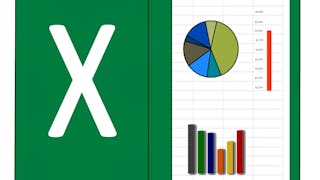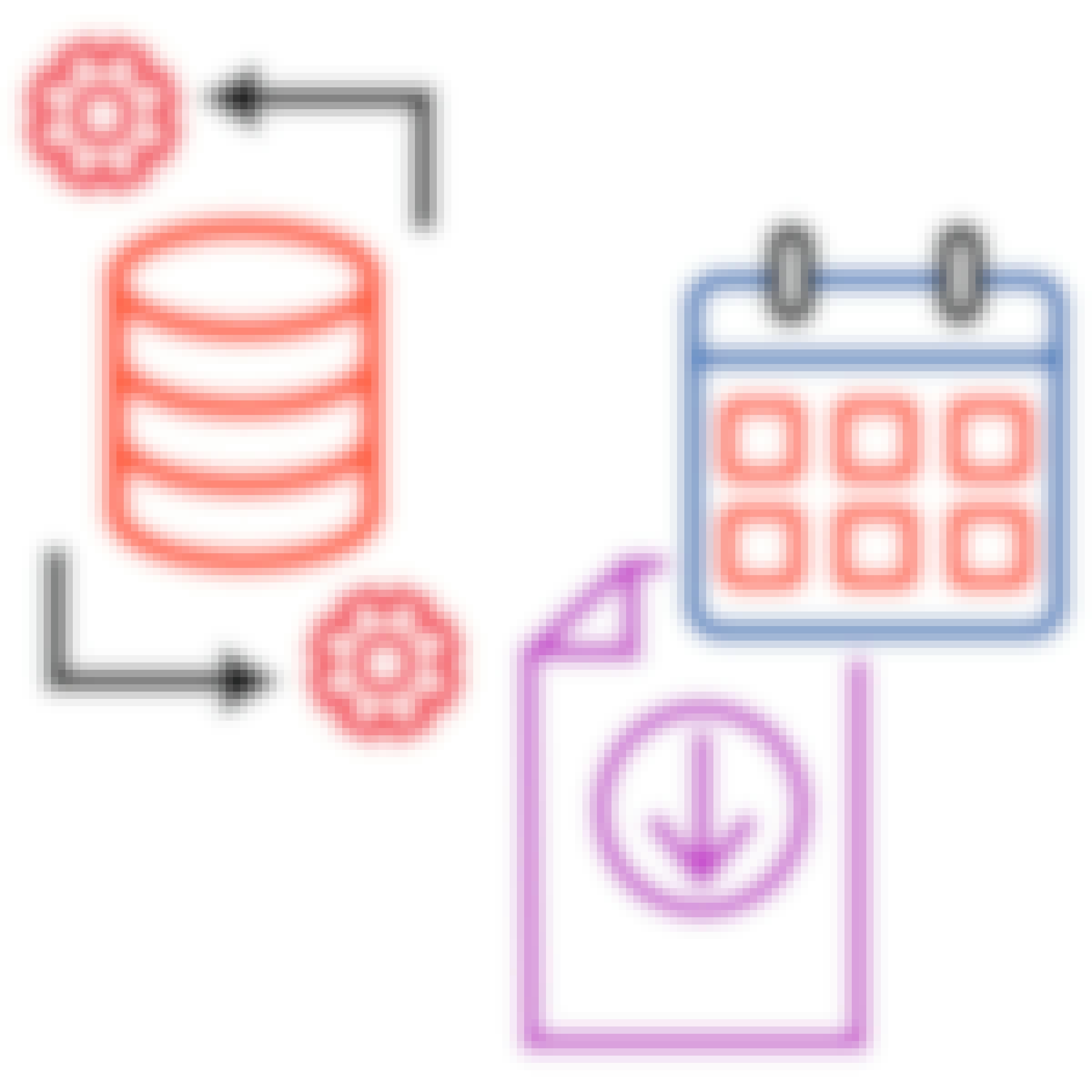- Browse
- Data Analysis Excel
Results for "data analysis excel"
 Status: Free TrialFree Trial
Status: Free TrialFree TrialSkills you'll gain: Excel Formulas, Microsoft Excel, Data Cleansing, Data Analysis, Data Import/Export, Spreadsheet Software, Data Wrangling, Data Quality, Pivot Tables And Charts, Google Sheets, Data Manipulation, Data Science, Data Integrity, Information Privacy
4.8·Rating, 4.8 out of 5 stars10K reviewsBeginner · Course · 1 - 3 Months

Skills you'll gain: Microsoft Excel, Excel Formulas, Spreadsheet Software, Pivot Tables And Charts, Data Analysis, Data Manipulation, Microsoft Office, Data Mining
4.7·Rating, 4.7 out of 5 stars4.4K reviewsIntermediate · Guided Project · Less Than 2 Hours
 Status: Free TrialFree TrialM
Status: Free TrialFree TrialMMacquarie University
Skills you'll gain: Pivot Tables And Charts, Data Storytelling, Power BI, Excel Formulas, Data Analysis Expressions (DAX), Data Visualization Software, Data Visualization, Interactive Data Visualization, Microsoft Excel, Dashboard, Data Modeling, Data Cleansing, Data Transformation, Data Manipulation, Excel Macros, Infographics, Spreadsheet Software, Data Analysis Software, Data Validation, Data Analysis
4.8·Rating, 4.8 out of 5 stars6K reviewsIntermediate · Specialization · 3 - 6 Months
 Status: Free TrialFree TrialStatus: AI skillsAI skillsI
Status: Free TrialFree TrialStatus: AI skillsAI skillsIIBM
Skills you'll gain: Exploratory Data Analysis, Data Storytelling, Data Wrangling, Dashboard, Data Visualization Software, Plotly, Data Visualization, Data Presentation, Interactive Data Visualization, Generative AI, SQL, Data Transformation, Data Analysis, Big Data, IBM Cognos Analytics, Excel Formulas, Professional Networking, Data Import/Export, Microsoft Excel, Python Programming
Build toward a degree
4.6·Rating, 4.6 out of 5 stars97K reviewsBeginner · Professional Certificate · 3 - 6 Months
 Status: PreviewPreviewJ
Status: PreviewPreviewJJohns Hopkins University
Skills you'll gain: Risk Modeling, Operations Research, Regression Analysis, Microsoft Excel, Business Analytics, Risk Analysis, Business Process Modeling, Business Modeling, Data Modeling, Resource Allocation, Analysis, Statistical Analysis, Mathematical Modeling, Process Optimization, Financial Analysis, Statistical Methods, Predictive Analytics, Transportation Operations, Complex Problem Solving, Linear Algebra
4.8·Rating, 4.8 out of 5 stars4K reviewsIntermediate · Course · 1 - 3 Months
 Status: NewNewStatus: Free TrialFree TrialM
Status: NewNewStatus: Free TrialFree TrialMMacquarie University
Skills you'll gain: Pivot Tables And Charts, Sample Size Determination, Data Visualization, Statistical Inference, Data Visualization Software, Statistical Hypothesis Testing, Statistics, Data-Driven Decision-Making, Microsoft Excel, Correlation Analysis, Descriptive Statistics, Probability & Statistics, Data Analysis, Forecasting, Regression Analysis, Business Analytics, Spreadsheet Software, Statistical Modeling, Statistical Visualization, Data Presentation
4.7·Rating, 4.7 out of 5 stars49 reviewsBeginner · Specialization · 3 - 6 Months
What brings you to Coursera today?
 Status: Free TrialFree TrialM
Status: Free TrialFree TrialMMicrosoft
Skills you'll gain: Excel Macros, Prompt Engineering, Microsoft Excel, Data Cleansing, Excel Formulas, Pivot Tables And Charts, Microsoft Copilot, Dashboard, Forecasting, Data Presentation, Data Storytelling, Data Processing, Data Visualization Software, Data Manipulation, Data Visualization, Workflow Management, Data Wrangling, Data Quality, Statistical Analysis, Data Transformation
4.2·Rating, 4.2 out of 5 stars269 reviewsBeginner · Professional Certificate · 3 - 6 Months
 Status: Free TrialFree Trial
Status: Free TrialFree TrialSkills you'll gain: Big Data, Data Analysis, Statistical Analysis, Apache Hadoop, Data Wrangling, Apache Hive, Data Collection, Data Mart, Data Science, Data Warehousing, Data Visualization, Analytics, Data Cleansing, Apache Spark, Data Lakes, Data Visualization Software, Microsoft Excel
4.8·Rating, 4.8 out of 5 stars20K reviewsBeginner · Course · 1 - 3 Months
 Status: Free TrialFree Trial
Status: Free TrialFree TrialSkills you'll gain: Excel Formulas, Microsoft Excel, Power BI, Spreadsheet Software, Timelines, Data Analysis, Data Manipulation, Data Presentation, Data Cleansing
4.7·Rating, 4.7 out of 5 stars5.2K reviewsBeginner · Course · 1 - 4 Weeks
 Status: Free TrialFree TrialM
Status: Free TrialFree TrialMMacquarie University
Skills you'll gain: Excel Formulas, Microsoft Excel, Data Cleansing, Data Manipulation, Spreadsheet Software, Data Transformation, Data Validation, Data Analysis, Pivot Tables And Charts, Automation
4.8·Rating, 4.8 out of 5 stars4.2K reviewsIntermediate · Course · 1 - 3 Months

Skills you'll gain: Excel Formulas, Spreadsheet Software, Microsoft Excel, Microsoft Office, Microsoft 365, Data Analysis, Business Mathematics
4.6·Rating, 4.6 out of 5 stars2.5K reviewsBeginner · Guided Project · Less Than 2 Hours

Skills you'll gain: Dashboard, Microsoft Excel, Microsoft 365, Microsoft Office, Spreadsheet Software, Data Visualization, Trend Analysis, Data Analysis
4.6·Rating, 4.6 out of 5 stars994 reviewsIntermediate · Guided Project · Less Than 2 Hours
In summary, here are 10 of our most popular data analysis excel courses
- Excel Basics for Data Analysis: IBM
- Introduction to Data Analysis using Microsoft Excel: Coursera
- Excel Skills for Data Analytics and Visualization: Macquarie University
- IBM Data Analyst: IBM
- Business Analytics with Excel: Elementary to Advanced: Johns Hopkins University
- Statistics and Data Analysis with Excel: Macquarie University
- Microsoft Excel: Microsoft
- Introduction to Data Analytics: IBM
- Preparing Data for Analysis with Microsoft Excel: Microsoft
- Excel Fundamentals for Data Analysis: Macquarie University
Frequently Asked Questions about Data Analysis Excel
Data Analysis Excel is a tool that allows users to perform various data analysis tasks using Microsoft Excel software. It provides a range of features and functions that enable the manipulation, visualization, and interpretation of data. With Data Analysis Excel, users can perform tasks such as data cleansing, filtering, sorting, and slicing. It also offers advanced statistical analysis tools, including regression, correlation, and hypothesis testing. This tool makes it easier for individuals and businesses to extract insights from their data and make data-driven decisions.
To excel in Data Analysis using Excel, you need to learn several skills. Here are some essential skills for Data Analysis with Excel:
Understanding Excel Functions: Familiarize yourself with important functions such as SUM, AVERAGE, COUNT, MAX, MIN, VLOOKUP, IF, INDEX, MATCH, and others. These functions will help you perform calculations and manipulate data efficiently.
Data Cleaning and Formatting: Learn how to clean and format data by removing duplicates, fixing inconsistencies, handling missing values, and structuring data appropriately. This step is crucial to ensure accurate analysis.
Pivot Tables and Charts: Master the usage of pivot tables and charts to summarize and analyze large sets of data. You should learn how to create, customize, and interpret pivot tables and charts to gain insights from your data effectively.
Advanced Excel Formulas: Expand your Excel skills by learning advanced formulas like conditional formatting, array formulas, and logical functions (such as IF, AND, OR). These formulas will help you perform complex calculations and automate tasks.
Data Visualization: Develop skills in creating visually appealing charts and graphs to present your data clearly and attractively. Learn to use various chart types, colors, and labels to communicate your analysis effectively.
Statistical Analysis: Acquire a basic understanding of fundamental statistical concepts, such as mean, median, mode, standard deviation, and correlation. Excel provides useful tools for calculating statistics, so learning how to apply them will enhance your data analysis abilities.
Macros and VBA: Although not mandatory, learning about macros and Visual Basic for Applications (VBA) can automate repetitive tasks and make your analysis more efficient. It allows you to customize Excel and write your own code for complex data manipulation.
- Data Analysis Tools: Explore and learn about Excel's built-in data analysis tools, such as Solver (for optimization problems), Goal Seek (for finding desired results), and Scenario Manager (for analyzing multiple scenarios). These tools will empower you to tackle more advanced analysis challenges.
Remember, practice and hands-on experience are equally important. Regularly working with real datasets, attempting case studies, and solving problems using Excel will help you develop a strong foundation in data analysis using Excel.
With data analysis Excel skills, you can pursue various job opportunities in the field of data analysis, such as:
Data Analyst: As a data analyst, you will be responsible for collecting, analyzing, and interpreting data to uncover insights, trends, and patterns. Excel skills are crucial for data manipulation, cleansing, and visualization.
Business Analyst: Excel skills are essential for business analysts who analyze data to help organizations make informed decisions. You will use Excel to create reports, perform quantitative analysis, and present findings to stakeholders.
Financial Analyst: Financial analysts utilize Excel extensively for financial modeling, data manipulation, and analysis. With strong data analysis skills in Excel, you can analyze financial statements, assess company performance, and make financial forecasts.
Market Research Analyst: Market research analysts use Excel to analyze survey data, conduct market analysis, and identify market trends. With Excel skills, you can effectively analyze large datasets, create charts, and generate insights to support marketing strategies.
Operations Analyst: Excel is widely used by operations analysts to track and analyze operational data, optimize processes, and improve efficiency. You can use Excel for data collection, analysis, and reporting, helping organizations streamline their operations.
Data Scientist: Data scientists combine statistical analysis, machine learning techniques, and programming skills to extract knowledge from large datasets. While Excel may not be the primary tool for data scientists, strong Excel skills are valuable for data manipulation and initial analysis.
- Project Manager: Project managers can benefit from Excel skills to track project performance, manage budgets, and analyze project data. You can utilize Excel for project planning, resource management, and optimization.
These are just some examples of the numerous job opportunities available to individuals with data analysis Excel skills. The versatility of Excel in data manipulation, analysis, and visualization makes it a valuable skill across various industries.
People who are detail-oriented, analytical, and have a strong interest in working with data are best suited for studying Data Analysis Excel. Additionally, individuals who are comfortable with numbers, have good problem-solving skills, and enjoy organizing and manipulating data will find this course beneficial.
Here are some topics that you can study related to Data Analysis in Excel:
Formulas and Functions: Learn various formulas and functions in Excel that are commonly used for data analysis such as SUMIFS, AVERAGEIFS, COUNTIFS, VLOOKUP, etc.
PivotTables: Understand how to create PivotTables in Excel to analyze and summarize large data sets efficiently.
Data Cleaning and Formatting: Learn techniques to clean and format data in Excel, including removing duplicates, handling missing values, and converting text to columns.
Charts and Graphs: Explore different types of charts and graphs in Excel to visualize and present data effectively.
Data Validation: Discover how to set up data validation rules in Excel to ensure data accuracy and consistency.
Conditional Formatting: Learn how to apply conditional formatting in Excel to highlight important trends, patterns, or outliers in your data.
Advanced Data Analysis Tools: Explore Excel's advanced features such as Solver, Goal Seek, and Scenario Manager to perform complex data analysis tasks.
Power Query: Understand how to use Power Query, a powerful data transformation and integration tool within Excel, to clean, shape, and load data from various sources.
Data Analysis using Excel Add-ins: Familiarize yourself with popular Excel add-ins like Analysis ToolPak, Power Pivot, and Power View that expand the capabilities of Excel for advanced data analysis.
- Statistical Analysis: Gain knowledge of basic statistical concepts and techniques, including regression analysis, correlation, t-tests, and hypothesis testing, to perform data analysis in Excel.
Remember, these topics are just a starting point, and there are many more areas to explore within data analysis using Excel. It's always beneficial to continue learning and stay updated with new features and tools that Excel offers.
Online Data Analysis Excel courses offer a convenient and flexible way to enhance your knowledge or learn new Data Analysis Excel is a tool that allows users to perform various data analysis tasks using Microsoft Excel software. It provides a range of features and functions that enable the manipulation, visualization, and interpretation of data. With Data Analysis Excel, users can perform tasks such as data cleansing, filtering, sorting, and slicing. It also offers advanced statistical analysis tools, including regression, correlation, and hypothesis testing. This tool makes it easier for individuals and businesses to extract insights from their data and make data-driven decisions. skills. Choose from a wide range of Data Analysis Excel courses offered by top universities and industry leaders tailored to various skill levels.
When looking to enhance your workforce's skills in Data Analysis Excel, it's crucial to select a course that aligns with their current abilities and learning objectives. Our Skills Dashboard is an invaluable tool for identifying skill gaps and choosing the most appropriate course for effective upskilling. For a comprehensive understanding of how our courses can benefit your employees, explore the enterprise solutions we offer. Discover more about our tailored programs at Coursera for Business here.










